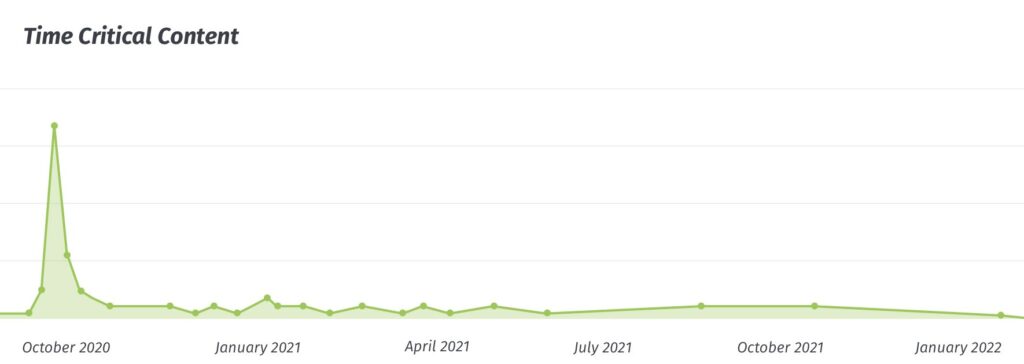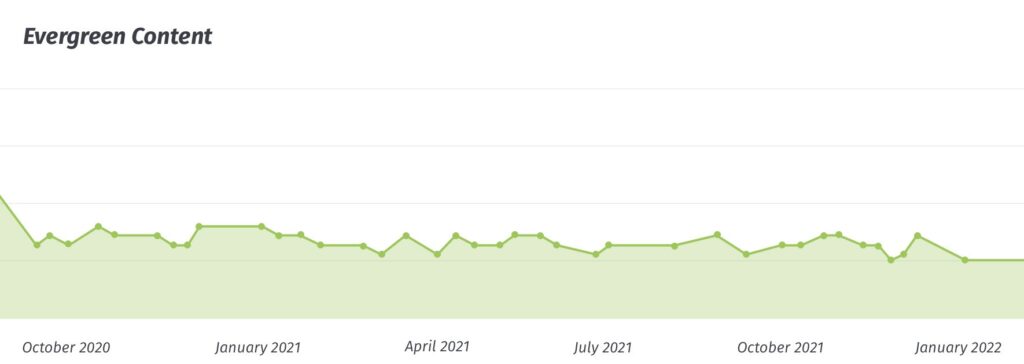What is Evergreen Content? Ideas and examples for creating and optimizing timeless content.

This article explains what constitutes evergreen content, how to write it and keep it up-to-date, and which formats are most suitable.
What is Evergreen Content?
“Evergreen content” describes content that is relevant regardless of the season or other time factors. The term is relatively new and mainly used in a digital marketing context. Evergreen content generates streams of visitors without being influenced by trends and market developments. The life cycle of regular blog posts starts with a brief high just after publication. This then levels off again until the post hardly brings in any user interaction after a while.

For evergreen posts, there is no significant slowdown in traffic over time. Ideally, the number of visitors and search engine rankings will even increase slowly. Even if an evergreen post generates rather low traffic directly after publication, it will yield more visitors overall than time-sensitive content.

Time-sensitive content vs. evergreen content
The opposite of evergreen content is all content that relates to current trends or constantly evolving topics. Examples would be the news, current developments in sports, or posts about seasonal fashion trends.
Example: “The top hits of 2016” would be an example of a time-sensitive post. Such a list would not become evergreen. However, a slideshow listing the top hits of each year since 2000 would have better chances.
Posts about historical events and facts that are not expected to change have a high evergreen potential. Especially encyclopedias or pages that publish definitions and how-to guides find it particularly easy to create evergreens. Therefore, Wikipedia.com is probably the most successful producer of evergreen content.
What are the benefits of evergreen content?
The production of successful evergreens is costly. Is it even worth it?
- The most significant benefit of evergreen content is constant traffic. If a website always sees a certain level of engagement, this sends positive signals to the search engines. Even though more current content may be having less success at the moment, this helps the site maintain a good reputation with Google. In addition, evergreen content tends to see higher dwell times and lower bounce rates. This also ultimately helps the reputation of the entire domain.
- Evergreen content also reduces the overall workload for the content marketing team. Especially smaller companies without the resources to create dozens of pieces of content every day should rely on evergreens. Those who mainly publish content on daily trends have significantly more work. Although evergreen content also requires a certain amount of maintenance and updates, it is much easier to manage than time-sensitive content.
- Publishing consistently relevant content also strengthens trust in the brand in the long term.. Evergreens are primarily created in informative formats such as instructions and definitions. Brands that can position themselves well with this type of content gain a particularly strong reputation. Potential customers associate brands that offer such content with seriousness and reliability.
How to identify evergreen potential?
First, it is important to understand the difference between evergreen content and evergreen topics. Evergreen topics are always of interest to the public. Examples would be a post on “How to rank in Google?” or the latest charts. Evergreen content is content that relates to these topics, such as a whitepaper called “the 101 SEO Guide.”
Using the current charts as an example, the difference between evergreen content and evergreen topics becomes clear: Although contemporary music is always sought-after and therefore an evergreen topic, it is impossible to write evergreen content about it. A post about the current hits will always be irrelevant in a few weeks.
So which topics are best to target with evergreens? That depends on the company, of course. In general, the target should be long-tail keywords. There is less competition here, and experience shows that persistent evergreens often relate to specific long-tail user questions.
Potential for evergreens usually exists in the niches of the respective industry. For example, a how-to guide on questions that often arise in the industry would be promising. Explanations of common concepts in the industry that are not known to outsiders also often become evergreens.
When doing keyword research, look for terms with consistently significant traffic. The trends must be either slightly increasing or seasonal, not decreasing. Evergreen content does not necessarily have to maintain the same traffic level because it is common for evergreen topics to experience sudden upticks.
Furthermore, evergreen content is only successful if the search intent for the targeted keyword is constant. For some terms, the reason they have googled changes with the season or after certain events. Such keywords have no evergreen potential.
Google Trends can easily determine how much traffic a certain keyword receives for free. This shows the direction in which the term is moving and how often it is searched for compared to other keywords. Specialized tools such as SemRush are more precise: In addition to the search volume, you can also see how much competition there is for the keyword and which search intent is being pursued.
What are examples of suitable evergreen formats and topics?
The content format also depends on the business, the target group, and the channel. In general, evergreens are found primarily in the following formats:
- Top “X” Lists.
- Step by Step Guides.
- Frequent mistakes in a particular area.
- How-to Guides.
- The history of a particular topic or niche.
- Expert Interviews
- “X widely held myths” in an industry or niche.
- Product reviews.
- “The complete guide” on a particular niche.
- List of best tools for a particular target or in a particular market.
- FAQs.
- The X best books on a particular topic.
After publication: How is Evergreen Content maintained?
It’s not enough to publish content once and then just “let it sit.” The competition in content marketing never sleeps. So Evergreen content also needs maintenance and updates.
For example, if a post contains year numbers , these must constantly be adjusted, especially regarding dates in titles. Google prefers recommending readers up-to-date content and therefore also takes the publication date or the date of the last update into account. The more often articles are updated, the better for SEO,and of course, the readers.
External and internal links should also be kept up to date. Links to outdated studies or websites that have not seen any updates themselves for a long time should be replaced. It also makes sense to place internal links to the older evergreen in the newer content. This way, Google sees that the evergreen is still relevant.
To realize the full potential of well-performing evergreens, they should also regularly be promoted on social media channels. Large newsrooms may not always be aware which of their posts have made it to evergreen status.
Parse.ly’s “Evergreen Report” shows which of the many pieces of content generate a lot of traffic for unusually long periods. This content should then be published again and again on several channels.
Furthermore, the competition should also be analyzed regularly. It may have been overtaken by another post. Therefore, it is important to find out what makes this content better than your own. This way, evergreens can also be constantly expanded. Depending on what Google is currently asking for, new image sections or infoboxes can be added even after a post has been published. Longer posts have become much more popular in recent years anyway.
Evergreen Content and Content Analytics Tools
Evergreen content only needs to be created once and generates traffic to the website over longer periods of time. The trick is to identify and implement the right topics and formats for your company.
Specialized tools for content analytics help with this and should be considered in a strategy change or relaunch project from the very beginning. Contact our experts if you would like to learn more about the implementation of content analytics tools.